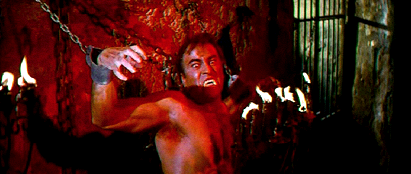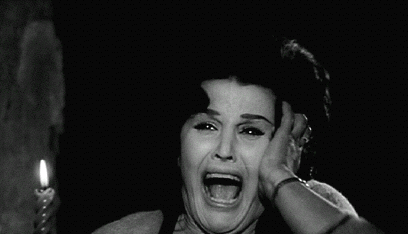Director: Enrique L. Eguiluz
Writer: Paul Naschy (as Jacinto Molina)
Producers: Maximiliano Pérez-Flores, Enrique Molina (uncredited)
Cast: Paul Naschy, Dyanik Zurakowska (as Dianik Zurakowska), Manuel Manzaneque, Julián Ugarte, Aurora de Alba, José Nieto, Carlos Casaravilla, Rosanna Yanni, Gualberto Galban, Antonio Jimenéz Escribano (as Antonio G. Escribano), Juan Medina, Rafael Alcantara, Antonio Orengo, Angela Rhu, Pilar Vela, Milagros Ceballos, Angel Menendez, Beatriz Savon, Maria Teresa Torralba, Victoriano Lopez
During a wolf hunt, Waldemar Daninsky (Paul Naschy) comes to the aide of his romantic rival Rudolph Weissmann (Manuel Manzaneque) who is being attacked by the werewolf Imre Wolfstein. Daninsky saves Rudolph’s life by stabbing the werewolf with a silver bladed cross, but not before being badly bitten. Daninsky inherits the werewolf curse and must hide himself away in the Wolfstein castle as he and Rudolph look for a cure to his condition.
The Flashback Fanatic movie review
When Molina got the “crazy” idea to make a horror film inspired by his early influences of such films as Frankenstein Meets the Wolf Man (1943), no one took him very seriously. In '60s Spain there had been no horror film tradition. Despite the prolific Spanish director Jesús Franco’s works, it was still assumed that only the United States and England should produce horror movies. Molina still pressed on writing a complete script called La marca del hombre lobo (The Mark of the Wolfman). Eventually, a German production company that wanted to shoot a film in their full color 70mm 3-D process took an interest in the script and helped finance the movie.
When plans to star the famous '40s Wolf Man Lon Chaney, Jr., fell through due to the actor’s failing health, one of the German producers suggested Molina play the part of his lycanthropic hero Waldemar Daninsky. Satisfied with Molina’s screen tests as man and monster, the producers green-lit the production. It was Molina’s first starring role and, initially, was a part he never envisioned himself playing. Once the filming and post-production was completed, Molina received a phone call from the producers. They were about to start the marketing of the film, but they insisted Molina be billed with a non-Spanish sounding name that would be better received internationally. They gave Molina half an hour to provide his own stage name or one would be chosen for him. From the names of the current Pope of the time (Paul VI) and a fellow weightlifting athlete from Hungary (Imre Nagy), Molina conceived the alias of Paul Naschy and the champion of Spanish horror was born.
Written and produced as The Mark of the Wolfman, this film is Naschy’s re-working of the Larry Talbot character and situations from The Wolf Man (1941). Again, we have a man of means who doesn’t quite fit in with the locals. Before long, he is wounded by a werewolf and afflicted with the curse of bestial transformations that compel him to murder. His plight is also made more tragic by the complications it creates for a new relationship he has begun with a beautiful local girl (Dyanik Zurakowska). That girl also has an earlier relationship that the hero is disrupting. There are even gypsies involved in the introduction of the werewolf menace who infects the hero.
Naschy’s main alteration to the template of The Wolf Man is more monsters. This probably also can be attributed to the influence of his beloved Frankenstein Meets the Wolf Man and the other Universal Pictures sequels that had multiple monsters in their plots. Naschy gives us two werewolves and two vampires. As if this horror reactor was reaching some sort of critical mass for a creepy creature chain reaction, it generates a Frankenstein connection due to the American distributor’s prior commitment to deliver a Frankenstein movie to the theaters. Sam Sherman, head of distributor Independent-International, concocted a narrated prologue that attached the Wolfstein family of the werewolf Imre Wolfstein to the Frankenstein family of monster-makers. That is the reason this movie was re-titled Frankenstein’s Bloody Terror, and why there is absolutely no Frankenstein stuff anywhere to be found in the actual film story. Considering that Frankenstein Meets the Wolf Man made such a profound impression on Naschy at an early age and was a major influence in his choice of material for his first script, it seems almost fitting that Frankenstein somehow worms its way into this flick.
This film is a great jumping off point for the man who would become an international horror icon. Although derivative, Naschy’s story delivers the goods to the drive-in crowd looking for some supernatural thrills and chills. The Wolfstein castle, crypt, and dungeon are great locations reeking with atmosphere. The characters of Dr. Janos Mikhelov (Julián Ugarte) and his wife Wandessa (Aurora de Alba) make a great, eerie first appearance at a fog-shrouded train station. The scenes of Waldemar Daninsky caged or chained in the dungeon while undergoing his transformations are the most memorable scenes for me. The lighting, shadows, music, groans, and Naschy’s performance all come together to make us realize the horror and torment of the werewolf.
Despite Sam Sherman’s meddling with the film title and prologue, I think the English version probably benefitted from an improved soundtrack. Some of the original Spanish language version clips I have seen have a different score from what is heard in Frankenstein’s Bloody Terror. If Sherman was involved with creating a different film score, I commend him for his choices. The music throughout this version is very good, and later filmmakers have re-used at least a couple of these tracks. These were probably library tracks that were found and substituted for the original Spanish score. If this was the case, I think this was an improvement, though I usually resent tampering by others unattached to a film’s production. I also have to say that it seems the werewolf growls of Daninsky are much better in the English version than what seems to be provided in the Spanish clips. I am still on the fence as to whether Sherman deciding to omit the opening ten and a half minutes from the film is an improvement. He is right in stating that the cut scenes were not essential to the story and that the edit gets the audience into the thick of things more quickly. As a result, however, we are immediately faced with characters we are trying to catch up with.
This film has a cast that should be of interest to any Euro-horror film fan. Paul Naschy begins his long horror film career playing his werewolf as a savage whirlwind. Dyanik Zurakowska is the angelic, blonde beauty Janice who provides the love interest for our tragic hero. She was a welcome attraction in other Spanish horrors such as Cauldron of Blood (1967) and The Vampires Night Orgy (1972). That other blonde beauty Rosanna Yanni (the gypsy Nascha) would be featured in more films with Paul Naschy. She also appeared in Amando de Ossorio’s first horror film, Fangs of the Living Dead (1969), along with this film’s Julián Ugarte. The sinfully sexy Aurora de Alba also makes a more revealing appearance in the later Naschy film Vengeance of the Zombies (1973).
Frankenstein’s Bloody Terror, aka The Mark of the Wolfman, certainly made its mark on the world of horror. It established the character of werewolf Waldemar Daninsky who would return in eleven more films. More importantly, it established the trajectory of Paul Naschy’s film career as a writer, actor, and eventual director. He would usually star in and sometimes direct his own screenplays. He made films in many genres, yet he would always return to horror. This horror hound admires and appreciates El Hombre Lobo’s versatility, enthusiasm, and prolific output. I still have many more Paul Naschy films to discover and look forward to each one.






























































